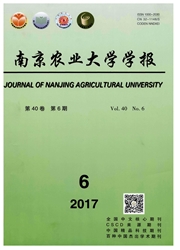

 中文摘要:
中文摘要:
采用温室盆栽试验,研究了不同含量菲处理对丹参根生物量、脂溶性有效成分(丹参酮ⅡA、隐丹参酮、丹参酮Ⅰ)的影响及菲在丹参根内的累积。结果表明:丹参收获后,土壤中的菲残留量为0.09~0.26mg·kg^-1,丹参根内菲含量为0.45~0.57mg·kg^-1;添加菲处理的丹参根生物量比对照略有增加,其有效成分丹参酮ⅡA的含量高于对照,但未达显著水平,隐丹参酮、丹参酮Ⅰ的含量显著高于对照(P〈0.05),3种丹参酮含量随土壤菲初始含量的增加而增加。菲含量在31.1和234.8mg·kg^-1时,对丹参根的生长有一定的刺激作用,促进了丹参酮在丹参根内的累积。
 英文摘要:
英文摘要:
Pot experiments were conducted in a greenhouse to study the effects of phenanthrene on root biomass and chemical components of Salvia miltiorrhiz. Results showed that at harvest,the residual contents of phenanthrene in spiked soils were in a range of 0. 090. 26 mg·kg^-1 and the concentrations of phenanthrene in roots of Salvia miltiorrhiza were in a range of 0. 450. 57 mg· kg^-1. The root biomass of S. miltiorrhiza grown in spiked soils was higher than that in control soils. The contents of TashinoneⅡA in roots of S. miltiorrhiza grown in spiked soils were higher than those in control soils. The contents of Cryptotashinone and Tashinone Ⅰgrown in spiked soils were significantly higher than those in control soils ( P 0. 05) . The Tashinones contents in roots of S. miltiorrhiza increased with the initial concentrations of phenanthren in soils. A slightly positive effect of phenanthrenea on the root growth and accumulation of tashinones in S. miltiorrhiza were observed.
 同期刊论文项目
同期刊论文项目
 同项目期刊论文
同项目期刊论文
 Arbuscular mycorrhizal fungal hyphae contribute to the uptake of polycyclic aromatic hydrocarbons by
Arbuscular mycorrhizal fungal hyphae contribute to the uptake of polycyclic aromatic hydrocarbons by Inhibition of free DNA degradation by the deformation of DNA exposed to trace polycyclic aromatic hy
Inhibition of free DNA degradation by the deformation of DNA exposed to trace polycyclic aromatic hy 期刊信息
期刊信息
